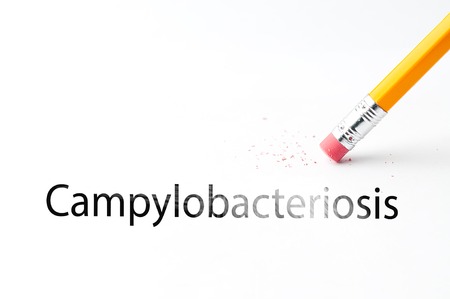
Bacterial human gastroenteritis is a very unpleasant foodborne disease and it is a continuing global problem (Eideh and Al-Qadiri, 2011; Nichols et al., 2012; Bolton, 2015). It is now a major food-borne pathogen and one that all food businesses in the meat and poultry industry strive to eradicate.
What Are The Campylobacter ?
Campylobacter are gram‐negative, slender, spirally curled, and microaerophilic bacteria that reside in the gastrointestinal tract of many different types of poultry and mammals.
The most common causative agents are the bacteria, Campylobacter, especially the species C. jejuni (90%) and C. coli (8%) (Dasti et al., 2010).
According to the WHO, cases of human campylobacteriosis, which is the disease caused by this bacteria have risen substantially, to claim 8.4% of the total diarrheal type diseases back in 2012 and still rising (Wilson et al., 2008; WHO, 2012). In 2012, campylobacteriosis was the second most prevalent bacterial foodborne illness reported in the U.S., with an incidence of 14.3 cases per 100,000 population (Gillis et al., 2013).
The most common occurrences happen after consuming uncooked or undercooked foods, especially meats and poultry in particular. The bacteria is often transferred to foods by cross-contamination through improper handling, usually from raw to cooked food which is a common example of transmittance (Domingues et al., 2012; Guyard-Nicodème et al., 2013; Jansaento et al., 2016; Skarp et al., 2016). The initial route is environmental because poultry often has Campylobacter residing on its skin and feathers, and in faeces.
Chicken is the number one primary reservoir for Campylobacter. Surveys conducted by the U.S. Department of Agriculture (USDA), Food Safety Inspection Service (FSIS), found 46.6% of young chickens (Anon. 2010) and 21.4% of chicken parts contaminated with Campylobacter spp. (Anon. 2014).
Poultry farming practices can be one of the issues if the birds are not cared for well enough. Broilers in particular appear prone to carrying food-borne disease bacteria and are the main route to infecting humans (EFSA, 2013). There is considerable pressure on retailers to supply one of the most popular meats because of its good nutritional worth and low cost as a result of literally mass production. In fact, in the last 6 years, broiler meat production in various formats has risen substantially by nearly 19% according to a report on Livestock and Poultry: World Markets and Trade (2013).
It was evident too that retailers were not checking their whole chickens in store as effectively as they might and this had become a newsworthy item (see post on the disturbing trend of contamination). Given the increase in demand for chicken generally, it is not surprising to see a rise in campylobacteriosis.
Better care and attention to preventing cross-contamination in broiler chickens would be ideal. Unfortunately, putting this into practice is not easy and there are no measures available to reduce the level of campylobacter infection (Hermans et al., 2011). The data on contamination tells us that 54% of all carcasses have the bacteria to levels of 3 log10 colony forming units (CFU/g) which is a measure of the number of bacteria on a carcass (Rosenquist et al., 2013). These authors also predicted that if a log reduction of 2 was possible the number of meal related cases of campylobacteriosis could be reduced 30 fold.
Reducing Campylobacter Levels In Food
Attempts to achieve a reduction in numbers are not forthcoming but methods based on killing the bacteria using antimicrobials, in spices and herbs and marinades might be feasible. What has intrigued scientists is the ability of the bacteria to survive in meat and poultry food even though it has highly specific growth conditions and is very sensitive to oxygen levels. One of the latest thoughts concerns their ability to form biofilms which are known to support survival (Brown et al., 2015; Feng et al., 2018).
References
Anon. (2010) The Nationwide Microbiological Baseline Data Collection Program: Young Chicken Survey July 2007–June 2008. http://www.fsis.usda.gov/wps/wcm/connect/deab6607-f081-41a4-90bf-8928d7167a71/Baseline_Data_Young_Chicken_2007-2008.pdf?MOD=AJPERES (accessed 11 October 2017)
Anon. (2014) The Nationwide Microbiological Baseline Data Collection Program: Raw Chicken Parts Survey January 2012–August 201.2 http://www.fsis.usda.gov/wps/wcm/connect/a9837fc8-0109-4041-bd0c-729924a79201/Baseline_Data_Raw_Chicken_Parts.pdf?MOD=AJPERES (accessed 11 October 2017).
(2015). Campylobacter virulence and survival factors. Food Microbiology, 48, pp. 99–108 (Article)
, , , , & (2015). Prevention of biofilm formation and removal of existing biofilms by extracellular DNases of Campylobacter jejuni. PLoS One, 10(3), e0121680. (Article).
Domingues, A.R., Pires, S.M., Halasa, T., Hald, T. (2012). Source attribution of human campylobacteriosis using a meta-analysis of case-control studies of sporadic infections. Epidemiol. Infect. 140(6) pp. 970–81
, , , , & (2010). Campylobacter jejuni: A brief overview on pathogenicity‐associated factors and disease‐mediating mechanisms. International Journal of Medical Microbiology, 300, pp. 205–211 (Article)
Eideh, A.M., Al-Qadiri, H.M. (2011) Effect of refrigerated and frozen storage on the survival of Campylobacter jejuni in cooked chicken meat breast. J. Food Sci. 76(1) M17–21.
European Food Safety Authority. (2013) The European union summary report on trends and sources of zoonoses, zoonotic agents and food-borne outbreaks in 2011. EFSA J. 11(4) pp. 3129. doi: 10.2903/j.efsa.2013.3129
, , , , & (2018). Environmental stress‐induced bacterial lysis and extracellular DNA release contribute to Campylobacter jejuni biofilm formation. Applied and Environmental Microbiology, 84. (Article).
, , and . (2013) Incidence and trends of infection with pathogens transmitted commonly through food–foodborne diseases active surveillance network, 10 U.S. sites, 1996-2012, MMWR. 62, pp. 283–287.
Guyard-Nicodème, M., Tresse, O., Houard, E., Jugiau, F., Courtillon, C., El Manaa, K., Laisney, M.J., Chemaly, M. (2013). Characterization of Campylobacter spp. transferred from naturally contaminated chicken legs to cooked chicken slices via a cutting board. Intl. J. Food Microbiol. 164(1) pp. 7–14.
Habib, I., Berkvens, D., De Zutter, L., Dierick, K., Van Huffel, X., Speybroeck, N., Geeraerd, A.H., Uyttendaele, M. (2012) Campylobacter contamination in broiler carcasses and correlation with slaughterhouses operational hygiene inspection. Food Microbiol. 29(1) pp. 105–12.
Hermans, D., Van Deun, K., Messens, W., Martel, A., Van Immerseel, F., Haesebrouck, F., Rasschaert, G., Heyndrickx, M., Pasmans, F. (2011). Campylobacter control in poultry by current intervention measures: urgent need for intensified fundamental research. Vet. Micobiol. 152(3–4) pp. 219–28
, , , & (2016). Detection of Campylobacter DNA using magnetic nanoparticles coupled with PCR and a colorimetric end‐point system. Food Science and Biotechnology, 25(1), pp. 193–198 (Article).
Nichols, G.L., Richardson, J.F., Sheppard, S.K., Lane, C., Sarran, C. (2012). Campylobacter epidemiology: a descriptive study reviewing 1 million cases in England and Wales between 1989 and 2011. BMJ Open 2:e001179. doi: 10.1136/bmjopen-2012-001179.
Rosenquist, H., Boysen, L., Krogh, A.L., Jensen, A.N., Nauta, M. (2013) Campylobacter contamination and the relative risk of illness from organic broiler meat in comparison with conventional broiler meat. Intl. J. Food Microbiol. 162(3) pp. 226–30
, , & (2016). Campylobacteriosis: The role of poultry meat. Clinical Microbiology and Infection, 22, pp. 103–109 (Article)
Wilson, D.J., Gabriel, E., Leatherbarrow, A.J., Cheesbrough, J., Gee, S., Bolton, E., Fox, A., Fearnhead, P., Hart, C.A., Diggle, P.J. (2008). Tracing the source of campylobacteriosis. PLoS Genet. 4(9):e1000203.
World Health Organization. (2012) The global view of Campylobacteriosis. Available from: https://extranet.who.int/iris/restricted/bitstream/10665/80751/1/9789241564601_eng.pdf. Accessed 2015 3rd January.

Leave a Reply